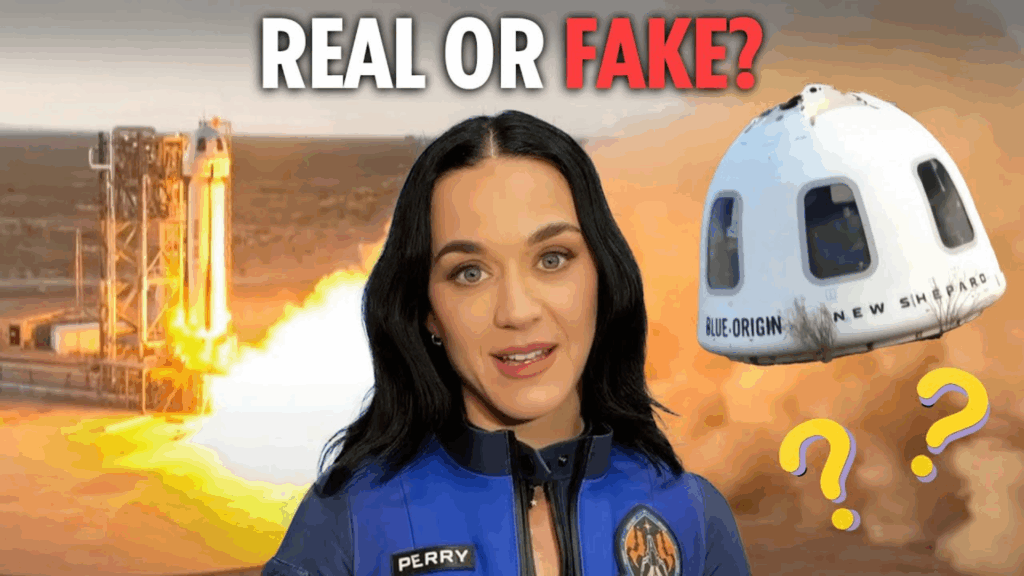Is Blue Origin’s Space Voyage a Hoax?
The suborbital flight NS-31 by Blue Origin on April 14, 2025, featuring an all-female crew including Katy Perry, Gayle King, and Lauren Sánchez, was hailed as a historic milestone for women in space exploration. However, shortly after the capsule landed, a wave of conspiracy theories flooded social media, alleging that the mission was a fabrication. From details like the capsule door opening unusually, a “plastic” hand, to the crew’s behavior, online “investigators” claim Blue Origin staged the entire event for[ to promote its brand. This article examines the main arguments behind these accusations while questioning their validity.

The Capsule Door: Technical Error or Staged?
One of the most cited “proofs” is footage showing the New Shepard capsule door opening from the inside before Jeff Bezos, Blue Origin’s founder, appeared to open it from the outside. According to articles from News18 and Yahoo News, skeptics argue that the capsule door can only be opened from the outside for safety reasons, such as ensuring a stable external environment and controlled cabin pressure. The door opening from within is seen as a major “flaw,” prompting many to label the mission a “hoax” akin to Moon landing conspiracy theories. Snopes noted this detail but has not received a response from Blue Origin to clarify whether this was a technical error or an intentional design.


The “Fake” Hand and “Too Clean” Capsule
A viral image showed a “plastic” hand inside the capsule, purportedly evidence that Blue Origin used a mannequin instead of real people. The Sun and The Economic Times clarified that this image was actually from a 2017 test flight featuring the Mannequin Skywalker, unrelated to NS-31. Nevertheless, the accusation went viral on social media, with users like @soswald1974 claiming “leaked footage” showed a mannequin in the capsule. Additionally, some argued the New Shepard was “too clean” and lacked burn marks from atmospheric re-entry, but Euronews explained that suborbital flights do not generate the high temperatures of orbital missions, thus leaving no burn marks.


Crew Behavior and CGI Imagery
The Daily Mail reported that Katy Perry’s hair did not move correctly in zero gravity, and Gayle King’s hand appeared to “disappear” in some frames, leading viewers to suspect the footage used CGI. Posts on X, such as one by @labondabon, called Perry’s behavior—like kissing the ground and singing “What a Wonderful World”—“theatrical fakery” to garner attention. Critics suggest zero-gravity scenes could have been filmed in a zero-gravity simulation aircraft, a technique common in filmmaking. However, no concrete evidence confirms the footage was fabricated.

Counterarguments and Lingering Questions
Despite the attention conspiracy theories have garnered, many accusations have been debunked. The “fake” hand image was from a different flight, and the New Shepard’s technical specifications explain the absence of burn marks. However, Blue Origin’s lack of transparency, such as not releasing raw data or live-streaming the entire mission, fuels skepticism. Compared to SpaceX, which frequently shares data publicly, Blue Origin is seen as tightly controlling information, creating opportunities for conspiracy theories to flourish.

The involvement of celebrities like Katy Perry, whose post-flight actions were perceived as performative, adds to the skepticism. Unlike NASA missions, which prioritize scientific expertise, Blue Origin’s choice of high-profile passengers raises questions about whether the mission was more about publicity than exploration. Additionally, the curated nature of the released footage, with cinematic editing and no real-time telemetry, contrasts with the openness expected from a genuine space mission.
The door-opening incident remains unresolved, as Blue Origin has not publicly addressed the discrepancy. While it could be a technical oversight or a design feature, the silence from the company allows speculation to persist. If the mission was genuine, skeptics argue, Blue Origin would invite independent verification from scientists or rival firms to dispel doubts, as NASA did during the Apollo era.

